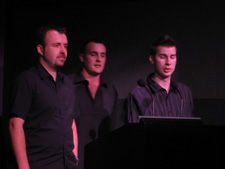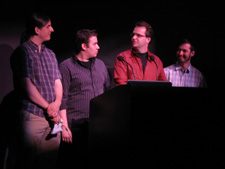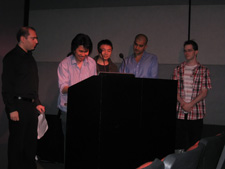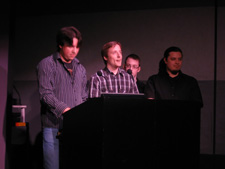VFS Grads Present Projects
 Vancouver – Last evening, the GD12 students at Vancouver Film School presented their grad projects to an evaluation audience in the VFS Main Theatre. The students spend several weeks in pre-production developing their game concepts, and then an additional 12 weeks in production, bringing their concepts to life.
Vancouver – Last evening, the GD12 students at Vancouver Film School presented their grad projects to an evaluation audience in the VFS Main Theatre. The students spend several weeks in pre-production developing their game concepts, and then an additional 12 weeks in production, bringing their concepts to life.
The first group up to the podium was Team LightSpeed, presenting their 2D Action Platformer game Travis’ Terror. The target audience for this imaginative and colourful game is children under 10, and to that end I feel that they came very close to making a product appropriate for the age group. Developed on Citrus
flash engine, the game’s environment is comprised of artwork which resembles colouring book drawings. The gameplay involves two modes: dreamtime and nightmare. In dreamtime mode, the environment is bright and colourful while nightmare mode has a darker colour palette. The premise of the game is to help Travis get through the game and defeat the boogeyman lurking in his closet. As the player advances through the levels, he is confronted by monsters such as dinosaurs and robots. In dreamtime mode, the monsters are small and easily defeatable. In nightmare mode the monsters are bigger and more challenging. Game progress can be saved at nightlight checkpoints, and there are toys and candies to collect along the way. The player can choose several different paths through the game, each path presenting different challenges. Travis’ Terror is a game which I feel showed hard work and attention to detail on the part of the development team, who overcame many challenges including losing a team member partway through the project.
Next to take the podium was Team Letter 6 with their game Curvature, which was developed using the
Unreal Engine. A physics based game, Curvature features a female hero named Belle who could adapt to three different modes. The basis of the game play is to use those modes to speed through the levels, guided by energy pins, with the ultimate goal to save a failing energy plant. The idea behind the game is good, but I felt on a personal level that the environment was too lacking in colour and texture, and Belle seemed unrefined. That said, the developers used flashes of colour to denote Belle’s action modes and signal the gamer when mode changes could be made. The team used skate parks and skate styles for both their environment and play mechanics. In this I feel the team was successful in translating to their product. The player could obtain a variety of achievements in this 3rd person platformer. What impressed me the most in the development process for the game was the amount of player feedback the team gathered from focus testing. They programmed two of the controller buttons to record “good” and “not good” moments as decided by the player. Along with the manually entered feedback, the team tracked where gamers went in the environment and used that knowledge to further develop the levels. Overall, I felt that this game showed good vision, imagination and innovation on the part of the students.
The third team to present their project was Team Trapd. This team also developed a game aimed at children. Count Pengula’s Castle features a group of colourful and humourous animals – Count Pengula the vampire penguin boss, his minions the Frankenstein Polar Bear and the Zombie Penguin, and of course our two
heroes, Joe the seven-armed Pirate Octopus (his eighth arm is a hook) and Wally the one-eyed vampiric walrus, who really owns the castle. The premise of the game is to make it through the castle using the team efforts of Joe and Wally, defeat the minions and then ultimately defeat Count Pengula, winning back the Wally’s castle. The team wrote their own game engine from scratch and it seems to work well except for a few glitches and audio problems. I noticed later in the evening when others were playing the game that it was sometimes difficult to figure out what to do next, or to gauge where characters could go. While there are tool tips throughout the game as indicated by large question marks, I felt that sometimes they could have been better placed to make for more intuitive gameplay. It was not always easy to figure out how to get the characters to move through different areas of some rooms to collect coins, which could lead to easy frustration for young players. The gamer controls both characters, making use of their distinctive abilities to work through the game. The one unique ability which I thought showed originality was Wally’s mist mode, which enabled him to not only glide from platform to platform, but he could be inhaled by Joe and “carried” to another area, where Joe could then exhale Wally, placing him where he needed to be.
The final game presented was Ascendancy, an imaginative third person platformer also built using the
Unreal Engine. The opening trailer for Ascendancy is very impressive – particularly the music. The character artwork is well done and the environment was realistic. The developers wanted to use movement as a design theme, and to this end developed a winged female heroine who needed to defeat the boss to regain possession her city. There is no actual combat or fighting in the game as the developer opted to use the environment to present the challenges. The player is lead through the levels by golden feathers, with blue and red feathers providing power-ups and special skills which the player would need to use to advance past the environment’s challenges. Obstacles such as falling rocks, bottomless pits and wind tunnels presented some of the challenge, while the boss’ minion would manufacture magical fields which the Queen would need to pass in order to get back to her city. Once the Queen arrives in the city, she must get past the boss character, avoiding his fireballs which are destroying her city. The city’s rubble becomes the challenge obstacle for the Queen, and she must make it into her palace before the city is destroyed. There are many features along the journey which show a backstory to the game, with writings and objects left behind by an earlier civilization. This
game, like the others before it, showed a great deal of work on concept and game mechanics; meant to target casual gamers, I think that this game’s prototype also shows great potential.
As always, I am impressed with the calibre of work generated by the VFS students – congratulations to the students and instructors for a job very well done. All of the students performed well during the “open play” session following the main presentation, and it’s always good to see former students and other professionals taking the time to attend the presentations and talk with the students afterward. Big Fish Games Vancouver Lead Programmer/Designer Jake Birkett offered a few tips to student Peter Liu from Trapd. We here at Village Gamer wish all of the GD12 students the best of luck as they venture out into the big world of game development, and we hope to see some of their future work emerging from local game studios in new and innovative titles.









1:15 pm on June 4th, 2009
Hey Tami, great article and thanks for all the props from all of us 🙂
Just one thing to note, the first team (my team) is “LightSpeed”.
Thanks again for the article, Dave made sure we all saw this 😀
1:34 pm on June 4th, 2009
Hi Mike, and you are most welcome – you all have much to be proud about in regards to your efforts. I’ve also corrected your team’s name – thanks for the heads’ up on that. =)